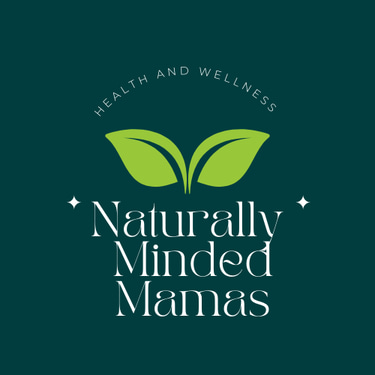The Naturally Minded Mama’s Complete Guide to Goldenrod: Healing, Tea, and Everyday Uses
Discover goldenrod's incredible benefits for allergies, sinus infections, and UTIs. Learn how to identify, harvest, and use this powerful herb with tincture recipes, tea blends, and dosing guidance for natural family wellness.


Goldenrod: Your Complete Guide to Nature's Powerful Sinus & Allergy Remedy
Every fall, something magical happens across North America: golden waves of goldenrod light up meadows and fields, creating a jubilant display that attracts monarch butterflies, beneficial insects, and—if you know what you're looking for—naturally minded mamas seeking powerful herbal medicine.
Here's what most people don't realize: goldenrod is one of the most effective natural remedies for sinus congestion, seasonal allergies, and urinary tract infections—and it's probably growing abundantly near you right now.
As naturally minded families committed to reducing our toxic load and using God's provision in nature, goldenrod deserves a place in every natural medicine cabinet. Today, I'm sharing everything you need to know about identifying, harvesting, preparing, and using this incredible herb.
What is Goldenrod? (And Why It Doesn't Cause Allergies!)
Scientific Name: Solidago spp.
Plant Family: Asteraceae (aster family)
Other Names: Woundwort, Aaron's rod, solidago
Let's clear up the biggest misconception first: Goldenrod does NOT cause hay fever or seasonal allergies!
Goldenrod has been wrongly accused simply because it blooms at the same time as the actual culprit: ragweed (Ambrosia spp.). Ragweed has demure green flowers that are easily overlooked, so by default, the showy golden goldenrod takes the blame.
Here's the key difference:
Ragweed releases wind-borne pollen that sails through the air to find your nostrils
Goldenrod is insect-pollinated and doesn't release pollen into the air—you'd have to stick your nose directly in the flowers to get any reaction
In fact, goldenrod is actually used to treat the very allergies it's accused of causing!
Goldenrod's Powerful Medicinal Benefits
Native American peoples have used various goldenrod species for centuries, both topically and internally. The medicinal use by over a dozen Native groups for close to twenty species has been documented, and modern herbalists continue to rely on this golden remedy.
1. Premier Sinus Decongestant
Goldenrod is one of the strongest herbs for drying the sinuses.
It effectively alleviates upper respiratory congestion from:
Seasonal allergies
Sinusitis
Common cold
Flu
Environmental allergies
How it works: Goldenrod is diuretic, astringent, and decongestant—a triple-action approach that dries excess mucus while reducing inflammation and fighting infection.
My experience: When sinus pressure hits our family, goldenrod tincture provides faster relief than anything else I've tried. Within 15-30 minutes, we notice improvement. No synthetic decongestants needed!
2. Urinary Tract Infection Treatment
Goldenrod has a special affinity for the urinary tract and works as:
Diuretic - Increases urine flow to flush out bacteria
Antimicrobial - Fights infection directly
Anti-inflammatory - Reduces pain and inflammation
It's particularly effective for:
Urinary tract infections (UTIs)
Bladder infections
Kidney stones (helps flush them)
Edema
Gout
3. Wound Healing & Skin Care
The scientific name Solidago means "to make whole"—and for good reason. Goldenrod has been used traditionally for:
Wounds and cuts
Burns
Open sores
Skin infections
Toothaches
Thrush
Native American peoples used goldenrod as a wash or poultice to heal wounds, and European settlers quickly adopted this practice.
4. Digestive Support
Goldenrod's bitter, warming, and pungent qualities make it a useful carminative herb that:
Stimulates digestion
Relieves gas and bloating
Helps with diarrhea (due to tannins and antimicrobial action)
Improves overall digestive function
5. Additional Benefits
Anti-inflammatory throughout the body
Antimicrobial against various pathogens
Vulnerary (promotes wound healing)
Diaphoretic (promotes sweating for fevers)
How to Identify Goldenrod Safely
CRITICAL SAFETY NOTE: While goldenrod is safe and beneficial, it has deadly look-alikes that you MUST learn to distinguish. Proper identification is essential before harvesting.
True Goldenrod Characteristics
Leaves:
Alternate (not opposite)
Simple (not compound)
Can be entire or slightly toothed
Hairy or smooth depending on species
Typically longer near the base of the plant
Stems:
Usually unbranched until flowering
Can be smooth or hairy
Flowers:
Yellow flower clusters (inflorescence)
Tiny individual flower heads (typically less than 0.4 inch across)
Each "flower" is actually made up of many tiny disc and ray florets
Arranged in racemes, panicles, or corymbs
Blooms late summer to early fall
Aroma Test: Crush a goldenrod leaf when the plant is in bloom—you'll detect hints of resin and a unique seaside-like fragrance (salt and balsam blend). This aromatic profile helps confirm you have true goldenrod.
DEADLY Look-Alikes to AVOID
Ragwort, groundsel, and related species (Senecio spp. and related genera) contain harmful pyrrolizidine alkaloids (PAs) that cause irreparable liver damage. These plants can be FATAL.
Key differences (though not foolproof):
Senecio species typically have fewer flower heads than goldenrod
Senecio flower heads are usually larger (more than 0.4 inch across)
Senecio species often bloom earlier in the season
Ragwort has lacy, divided leaves; goldenrod leaves are simple
IMPORTANT: Get a local field guide and become familiar with both goldenrod AND the toxic look-alikes in your area before harvesting. When in doubt, DON'T harvest.
Goldenrod vs. Ragweed (The Real Allergy Culprit)
Ragweed characteristics:
Lacy-looking, divided leaves
Freely branching stems
Demure green flowers (easy to overlook)
CAUSES allergies through wind-borne pollen
Goldenrod characteristics:
Simple, undivided leaves
Often unbranched stem until flowering
Bright yellow, showy flowers
Does NOT cause allergies (insect-pollinated)
Where to Find Goldenrod
Goldenrod loves:
Meadows and fields
Open woods
Trail sides and waysides
Disturbed areas
Sunny to partially shaded locations
Range: Almost anyone in North America has at least several abundant local species. Some species have escaped cultivation in Europe and China.
Good news: Any goldenrod species can be used medicinally! You don't need to identify to the specific species level—just make absolutely sure you have a true Solidago genus goldenrod and not a toxic look-alike.
How to Harvest Goldenrod Responsibly
Best time to harvest: When plants are just beginning to flower
Why this timing matters:
Ensures dried blooms retain their golden color
If you harvest in full bloom, flowers will mature into fluffy seed heads as they dry
You'll be left with dull puffs instead of golden floral beauty
Sustainable harvesting guidelines:
For multi-stemmed species:
Leave half the stems intact for pollinators and plant vitality
Cut stems with clean, sharp pruners
For single-stemmed species:
Cut the stem halfway down
Leave vegetation to photosynthesize for the remainder of the season
Always:
Make sure the species is abundant in your area
Leave the majority of plants untouched
Harvest plants with healthy-looking leaves (no powdery mildew)
Never harvest more than you need
Drying: Hang plants to dry in bundles. When crisp, strip leaves and flowers from stems and store in glass jars away from light.
Pro tip: If powdery mildew is common in your area, harvest leaves earlier in the season before mildew takes hold.
How to Use Goldenrod: Preparations & Dosing
Goldenrod Tea (Infusion)
For sinus congestion, allergies, or digestive support:
Ratio: 1-2 teaspoons (5-10 ml) dried leaves and flowers per 1 cup (240 ml) boiling water
Method:
Place dried goldenrod in a mug
Pour boiling water over herbs
Cover and steep 10-15 minutes
Strain and drink
Dosage: Up to 3 cups daily
Taste: Piney, slightly bitter, warming
Goldenrod Tincture
Tincture ratios:
Fresh flowering herb: 1:2 ratio with 95% alcohol
Dried flowering herb: 1:4 ratio with 60% alcohol
Dosage: 2-4 ml (about ½ to ¾ teaspoon) three times daily
Why tincture? Tinctures are more concentrated, faster-acting, and convenient for on-the-go use. Remember: our bodies absorb about 98% of tinctures vs. only 50% of capsules!
Powerful Sinus Relief Formula
This is my go-to formula for allergies, colds, flu, and sinus congestion:
Ingredients:
2 fl oz goldenrod tincture (flowering tops)
2 fl oz elderflower tincture
1 fl oz yarrow flower tincture
1 fl oz nettle leaf tincture
Method:
Combine all tinctures in a glass dispensing bottle
Shake gently to mix
Label with ingredients and date
Dosage: 4 ml (⅘ teaspoon) three times daily
Why this formula works:
Goldenrod - Premier decongestant, dries sinuses Elderflower - Antiviral, dries mucus, reduces inflammation Yarrow - Antimicrobial, anti-inflammatory, pain relief Nettle - Antihistamine, anti-inflammatory, drying to sinuses
This synergistic blend addresses allergies and sinus congestion from multiple angles!
Urinary Tract Infection Tea
Ingredients (equal parts):
Goldenrod (flowering tops)
Marshmallow root
Corn silk
Uva-ursi
Method:
Combine herbs in equal amounts
Use 2-3 teaspoons per cup of boiling water
Steep 15-20 minutes
Strain and drink at room temperature
Dosage: 3-4 cups daily until infection resolves
Why these herbs: Goldenrod provides antimicrobial and diuretic action, marshmallow soothes irritated tissues, corn silk reduces inflammation, and uva-ursi is a powerful urinary antiseptic.
Other Preparation Methods
Vinegar infusion: Goldenrod's resiny flavor melds nicely with vinegar—use for salad dressings or as an herbal vinegar tonic
Infused honey: Steep fresh goldenrod flowers in raw honey for 2-4 weeks; strain and use as immune support
Syrup: Make a strong tea, add honey, and reduce to syrup consistency for a pleasant-tasting sinus remedy
Wound wash: Strong infusion applied topically to cuts, burns, and skin infections
Growing Goldenrod in Your Garden
Why grow goldenrod?
Consistent supply of medicine
Attracts beneficial insects and pollinators
Supports over 100 species of caterpillars
Stunning fall color in the garden
Low maintenance once established
Growing conditions:
Zones: 3-9 (varies by species)
Light: Full sun to part shade
Soil: Adaptable to most soils
Size: 2-5 feet tall
Spread: Some species spread aggressively by runners; others clump modestly
Propagation:
From seed: Stratify for 3 months, sow on soil surface (don't bury)
Cuttings: Softwood cuttings with 4-6 nodes in late spring
Division: Divide roots in spring or early summer
Transplanting: Plants transplant well early in season
Best species for small gardens:
Sweet goldenrod (S. odora) - Anise-like fragrance, prized for tea
S. rugosa 'Fireworks' - Mildew-resistant, slowly spreading
'Baby Sun' and 'Goldkind' hybrids - Tight clumping habit
S. sphacelata 'Golden Fleece' - Late-flowering with heart-shaped leaves
Garden companions:
Ironweed (Vernonia)
Joe Pye weed (Eutrochium)
Common milkweed (Asclepias syriaca)
Cup plant (Silphium perfoliatum)
Maintenance: Minimal! Watch for powdery mildew and rust in humid climates. Choose resistant varieties if this is an issue.
Safety Considerations & Contraindications
Do not use if:
Pregnant - Goldenrod is contraindicated during pregnancy
Allergic to Asteraceae family - Those with aster family allergies should exercise caution (though reactions are rare)
Cautions:
Overly drying - Goldenrod can be too drying as a tonic herb for people with dry constitutions, dry skin, or dry mucous membranes. Short-term use is fine.
Allergic reactions - Rare cases of contact dermatitis have occurred from both handling and internal use
Diuretic effects - May compound pharmaceutical diuretics; consult your doctor if taking blood pressure medications
Always:
Start with small doses to test tolerance
Ensure proper identification before harvesting
Consult a healthcare provider if you're on medications
Stop use if any adverse reactions occur
A Faith-Centered Perspective on Goldenrod
As naturally minded mamas, we understand that God designed every plant with purpose. Goldenrod's golden blooms aren't just beautiful—they're a gift for healing that's been waiting in fields and meadows for centuries.
St. Hildegard of Bingen taught that we should recognize and use the healing properties God placed in creation. When we learn to identify goldenrod, harvest it respectfully, and prepare it into medicine for our families, we're participating in the stewardship God calls us to.
The name Solidago means "to make whole"—and that's exactly what this herb does when we use it with knowledge and gratitude.
Final Thoughts: Embracing God's Golden Gift
Goldenrod is one of those herbs that seems almost too good to be true:
It's abundant and free
It grows wild across most of North America
It's incredibly effective for common ailments
It's easy to identify (once you learn the key features)
It can be prepared multiple ways
It's safe for most people when used appropriately
Every fall, I look forward to goldenrod season. Harvesting these golden blooms has become a family tradition—my children help identify the plants, we gather respectfully, and we hang bundles to dry in our kitchen.
When winter comes and someone gets a sinus infection or UTI, we have our goldenrod tincture ready. No need for synthetic decongestants with their long list of side effects. No trips to the pharmacy. Just simple, effective plant medicine.
This is the kind of wellness knowledge our great-grandparents possessed instinctively—and we have the privilege of reclaiming it.
Start this season by learning to identify goldenrod in your area. Take a nature walk with your children and look for those golden plumes. Harvest respectfully. Make medicine. And experience the transformative power of using what God provided for our healing.
Your family deserves this kind of natural, effective, toxin-free medicine. And goldenrod is ready to deliver.
Have you used goldenrod for your family's health? What was your experience? I'd love to hear your stories and answer any questions about identifying or using this amazing herb!
Disclaimer: This information is for educational purposes only and is not intended to diagnose, treat, cure, or prevent any disease. Always properly identify plants before use and consult with a qualified healthcare provider before using herbs, especially if you're pregnant, nursing, or taking medications. Goldenrod has deadly look-alikes—proper identification is essential.






